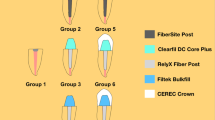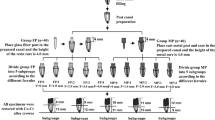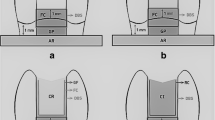Abstract
Objectives
This study aims to evaluate the fracture resistance of endodontically treated anterior teeth restored with crowns made of composite or ceramic and retained without the use of a post (endocrowns) or with posts of 5 mm (short) and 10 mm in length (long).
Material and methods
Forty-eight intact maxillary incisors were selected for the study. After endodontic treatment, the crowns were sectioned 2 mm coronally to the cementoenamel junction provided with a ferrule of 2 mm. The roots were randomly divided into six groups (n = 8) according to the post length and type of coronary restoration. The crowns were fabricated with the chairside economical restoration of esthetic ceramics system. Group 1 was restored with a 10-mm glass fiber post, composite core, and a full-coverage ceramic crown (LPCer); group 2, with a 5-mm glass fiber post, composite core, and a full-coverage ceramic crown (SPCer); group 3, with a 10-mm glass fiber post, composite core, and a full-coverage composite crown (LPCpr); group 4, with a 5-mm glass fiber post, composite core, and a full-coverage composite crown (SPCpr); and groups 5 (EndoCer) and 6 (EndoCpr) were restored with ceramic and composite endocrowns, respectively. The teeth were then thermomechanically loaded in a chewing machine. After fatigue, the specimens were loaded to fracture. Data were analyzed with ANOVA and chi-square test. Mode of failure was defined as repairable or non-repairable.
Results
Presence of post, post length, and crown material had no significant effect on the fracture resistance. Groups restored with endocrowns presented a higher number of repairable fractures in respect to the other groups.
Conclusions
Presence of a post had no effect on the restorations’ fracture strength.
Clinical relevance
Although this in vitro study has some limitations in respect to its clinical relevance, the restoration of largely destroyed anterior teeth with the use of an endocrown or a short glass fiber post might have advantages over a large glass fiber post.



Similar content being viewed by others
References
Goodacre CJ, Spolnik KJ (1995) The prosthodontic management of endodontically treated teeth: a literature review. Part III. Tooth preparation considerations. J Prosthodont 4:122–128
Abramovitz L, Lev R, Fuss Z, Metzger Z (2001) The unpredictability of seal after post space preparation: a fluid transport study. J Endod 27:292–295
Akkayan B, Gulmez T (2002) Resistance to fracture of endodontically treated teeth restored with different post systems. J Prosthet Dent 87:431–437
Goldberg AJ, Burstone CJ (1992) The use of continuous fiber reinforcement in dentistry. Dent Mater 8:197–202
Mannocci F, Ferrari M, Watson TF (1999) Intermittent loading of teeth restored using quartz fiber, carbon-quartz fiber, and zirconium dioxide ceramic root canal posts. J Adhes Dent 1:153–158
Krejci I, Duc O, Dietschi D, de Campos E (2003) Marginal adaptation, retention and fracture resistance of adhesive composite restorations on devital teeth with and without posts. Oper Dent 28:127–135
Dietschi D, Duc O, Krejci I, Sadan A (2007) Biomechanical considerations for the restoration of endodontically treated teeth: a systematic review of the literature—Part 1. Composition and micro- and macrostructure alterations. Quintessence Int 38:733–743
Garbin CA, Spazzin AO, Meira-Junior AD, Loretto SC, Lyra AM, Braz R (2010) Biomechanical behaviour of a fractured maxillary incisor restored with direct composite resin only or with different post systems. Int Endod J 43:1098–1107
Isidor F, Brondum K, Ravnholt G (1999) The influence of post length and crown ferrule length on the resistance to cyclic loading of bovine teeth with prefabricated titanium posts. Int J Prosthodont 12:78–82
Nissan J, Dmitry Y, Assif D (2001) The use of reinforced composite resin cement as compensation for reduced post length. J Prosthet Dent 86:304–308
Nissan J, Barnea E, Bar Hen D, Assif D (2008) Effect of remaining coronal structure on the resistance to fracture of crowned endodontically treated maxillary first premolars. Quintessence Int 39:183–187
Nergiz I, Schmage P, Platzer U, Ozcan M (2002) Bond strengths of five tapered root posts regarding the post surface. J Oral Rehabil 29:330–335
Scotti N, Scansetti M, Rota R, Pera F, Pasqualini D, Berutti E (2011) The effect of the post length and cusp coverage on the cycling and static load of endodontically treated maxillary premolars. Clin Oral Investig 15:923–929
Hikita K, Van Meerbeek B, De Munck J, Ikeda T, Van Landuyt K, Maida T, Lambrechts P, Peumans M (2007) Bonding effectiveness of adhesive luting agents to enamel and dentin. Dent Mater 23:71–80
Lander E, Dietschi D (2008) Endocrowns: a clinical report. Quintessence Int 39:99–106
Zarone F, Sorrentino R, Apicella D, Valentino B, Ferrari M, Aversa R, Apicella A (2006) Evaluation of the biomechanical behavior of maxillary central incisors restored by means of endocrowns compared to a natural tooth: a 3D static linear finite elements analysis. Dent Mater 22:1035–1044
Reiss B, Walther W (2000) Clinical long-term results and 10-year Kaplan-Meier analysis of Cerec restorations. Int J Comput Dent 3:9–23
Rusin RP (2001) Properties and applications of a new composite block for CAD/CAM. Compend Contin Educ Dent 22:35–41
Wittneben JG, Wright RF, Weber HP, Gallucci GO (2009) A systematic review of the clinical performance of CAD/CAM single-tooth restorations. Int J Prosthodont 22:466–471
Krejci I, Lutz F, Reimer M, Heinzmann JL (1993) Wear of ceramic inlays, their enamel antagonists, and luting cements. J Prosthet Dent 69:425–430
Krejci I, Lutz F (1991) Marginal adaptation of Class V restorations using different restorative techniques. J Dent 19:24–32
Lutz F, Krejci I, Imfeld T, Elzer A (1991) The hydrodynamic behavior of dentinal tubule fluid under occlusal loading. Schweiz Monatsschr Zahnmed 101:24–30
Murphy TR (1965) The timing and mechanism of the human masticatory stroke. Arch Oral Biol 10:981–994
Bates JF, Stafford GD, Harrison A (1976) Masticatory function—a review of the literature III. Masticatory performance and efficiency. J Oral Rehabil 3:57–67
Neill DJ, Kydd WL, Nairn RI, Wilson J (1989) Functional loading of the dentition during mastication. J Prosthet Dent 62:218–228
Heintze SD, Cavalleri A, Zellweger G, Buchler A, Zappini G (2008) Fracture frequency of all-ceramic crowns during dynamic loading in a chewing simulator using different loading and luting protocols. Dent Mater 24:1352–1361
Loney RW, Moulding MB, Ritsco RG (1995) The effect of load angulation on fracture resistance of teeth restored with cast post and cores and crowns. Int J Prosthodont 8:247–251
Volwiler RA, Nicholls JI, Harrington GW (1989) Comparison of three core buildup materials used in conjunction with two post systems in endodontically treated anterior teeth. J Endod 15:355–361
Pene JR, Nicholls JI, Harrington GW (2001) Evaluation of fiber-composite laminate in the restoration of immature, nonvital maxillary central incisors. J Endod 27:18–22
Zhi-Yue L, Yu-**ng Z (2003) Effects of post-core design and ferrule on fracture resistance of endodontically treated maxillary central incisors. J Prosthet Dent 89:368–373
Hu YH, Pang LC, Hsu CC, Lau YH (2003) Fracture resistance of endodontically treated anterior teeth restored with four post-and-core systems. Quintessence Int 34:349–353
Schmitter M, Huy C, Ohlmann B, Gabbert O, Gilde H, Rammelsberg P (2006) Fracture resistance of upper and lower incisors restored with glass fiber reinforced posts. J Endod 32:328–330
Hayashi M, Takahashi Y, Imazato S, Ebisu S (2006) Fracture resistance of pulpless teeth restored with post-cores and crowns. Dent Mater 22:477–485
Salameh Z, Sorrentino R, Ounsi HF, Goracci C, Tashkandi E, Tay FR, Ferrari M (2007) Effect of different all-ceramic crown system on fracture resistance and failure pattern of endodontically treated maxillary premolars restored with and without glass fiber posts. J Endod 33:848–851
Tan PL, Aquilino SA, Gratton DG, Stanford CM, Tan SC, Johnson WT, Dawson D (2005) In vitro fracture resistance of endodontically treated central incisors with varying ferrule heights and configurations. J Prosthet Dent 93:331–336
Plotino G, Grande NM, Bedini R, Pameijer CH, Somma F (2007) Flexural properties of endodontic posts and human root dentin. Dent Mater 23:1129–1135
Stewardson DA, Shortall AC, Marquis PM, Lumley PJ (2010) The flexural properties of endodontic post materials. Dent Mater 26:730–736
Chuang SF, Yaman P, Herrero A, Dennison JB, Chang CH (2010) Influence of post material and length on endodontically treated incisors: an in vitro and finite element study. J Prosthet Dent 104:379–388
Asmussen E, Peutzfeldt A, Sahafi A (2005) Finite element analysis of stresses in endodontically treated, dowel-restored teeth. J Prosthet Dent 94:321–329
Seow LL, Toh CG, Fok AS, Wilson NH (2008) A finite element analysis of ceramic restorations in endodontically treated premolars. Am J Dent 21:331–336
Vivadent I (issued October 2011) Retrieved online January 2013 from: http://wwwivoclarvivadentus/en-us/download-center/scientific-documentation/
ESPE M (Issued 2000) Retrived online January 2013 from: http://multimedia3mcom/mws/mediawebserver?6666660Zjcf6lVs6EVs666zQcCOrrrrQ-
Ferrari M, Cagidiaco MC, Grandini S, De Sanctis M, Goracci C (2007) Post placement affects survival of endodontically treated premolars. J Dent Res 86:729–734
Fragou T, Tortopidis D, Kontonasaki E, Evangelinaki E, Ioannidis K, Petridis H, Koidis P (2012) The effect of ferrule on the fracture mode of endodontically treated canines restored with fibre posts and metal-ceramic or all-ceramic crowns. J Dent 40:276–285
Dietschi D, Duc O, Krejci I, Sadan A (2008) Biomechanical considerations for the restoration of endodontically treated teeth: a systematic review of the literature, Part II (Evaluation of fatigue behavior, interfaces, and in vivo studies). Quintessence Int 39:117–129
Fokkinga WA, Kreulen CM, Vallittu PK, Creugers NH (2004) A structured analysis of in vitro failure loads and failure modes of fiber, metal, and ceramic post-and-core systems. Int J Prosthodont 17:476–482
Heydecke G, Butz F, Strub JR (2001) Fracture strength and survival rate of endodontically treated maxillary incisors with approximal cavities after restoration with different post and core systems: an in-vitro study. J Dent 29:427–433
Juloski J, Radovic I, Goracci C, Vulicevic ZR, Ferrari M (2012) Ferrule effect: a literature review. J Endod 38:11–19
Giovani AR, Vansan LP, de Sousa Neto MD, Paulino SM (2009) In vitro fracture resistance of glass-fiber and cast metal posts with different lengths. J Prosthet Dent 101:183–188
Biacchi GR, Basting RT (2012) Comparison of fracture strength of endocrowns and glass fiber post-retained conventional crowns. Oper Dent 37:130–136
Nayyar A, Walton RE, Leonard LA (1980) An amalgam coronal-radicular dowel and core technique for endodontically treated posterior teeth. J Prosthet Dent 43:511–515
Acknowledgments
The authors thank the help with illustrations provided by Edgar Ramírez. We also appreciate the help of manufacturers for graciously providing us the materials for the present study—Kuraray (Osaka, Japan), Ivoclar Vivadent (Schaan, Liechtenstein), and 3M ESPE (Germany).
Conflict of interest
The authors declare that they have no conflict of interest.
Author information
Authors and Affiliations
Corresponding author
Rights and permissions
About this article
Cite this article
Ramírez-Sebastià, A., Bortolotto, T., Cattani-Lorente, M. et al. Adhesive restoration of anterior endodontically treated teeth: influence of post length on fracture strength. Clin Oral Invest 18, 545–554 (2014). https://doi.org/10.1007/s00784-013-0978-3
Received:
Accepted:
Published:
Issue Date:
DOI: https://doi.org/10.1007/s00784-013-0978-3




